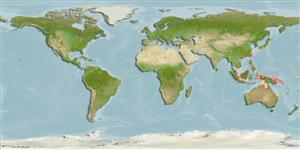Environment: milieu / climate zone / depth range / distribution range
Ecología
marino bentopelágico; rango de profundidad 1 - 40 m (Ref. 9772). Tropical
Distribución
Países | Áreas FAO | Ecosistemas | Ocurrencias, apariciones | Point map | Introducciones | Faunafri
Western Pacific: Taiwan, Hong Kong, Shanghai and Singapore.
Tamaño / Peso / Age
Maturity: Lm ? range ? - ? cm
Max length : 22.0 cm SL macho / no sexado; (Ref. 124713); common length : 14.0 cm SL macho / no sexado; (Ref. 9772); peso máximo publicado: 135.27 g (Ref. 124713)
Short description
Morfología | Morfometría
Espinas dorsales (total): 10 - 11; Radios blandos dorsales (total): 24-27; Espinas anales 2; Radios blandos anales: 7 - 8. Small species with a moderately elongate body. Dark mottled pattern dorsally, creamy white ventrally; scale pockets on dorsal side of head and body with broad, dark margins; spinous dorsal fin black, pectoral fins grey, pelvic fins pale (Ref. 9772).
Inhabits shallow coastal waters (Ref. 9772).
Life cycle and mating behavior
Madurez | Reproducción | Puesta | Huevos | Fecundidad | Larva
Sasaki, K., 1992. Two new and two resurrected species of the sciaenid genus Johnius (Johnius) from the West Pacific. Jap. J. Ichthyol. 39(3):191-199. (Ref. 10084)
IUCN Red List Status (Ref. 130435)
Threat to humans
Harmless
Human uses
Pesquerías: escaso valor comercial
Más información
PaísesÁreas FAOEcosistemasOcurrencias, aparicionesIntroduccionesStocksEcologíaDietacomponentes alimenticiosconsumo de alimentoRación
Nombres comunesSinónimosMetabolismoDespredadoresEcotoxicologíaReproducciónMadurezPuestaAgregación para la puestaFecundidadHuevosEgg development
ReferenciasAcuiculturaPerfil de acuiculturaRazasGenéticaElectrophoresesheritabilidadEnfermedadesProcesamientoNutrientsMass conversion
ColaboradoresImágenesStamps, Coins Misc.SonidosCiguateraVelocidadTipo de nataciónSuperficie branquialOtolitosCerebrosVisión
Herramientas
Special reports
Download XML
Fuentes de Internet
Estimates based on models
Preferred temperature (Ref.
123201): 24.7 - 29.1, mean 28.4 °C (based on 648 cells).
Phylogenetic diversity index (Ref.
82804): PD
50 = 0.5000 [Uniqueness, from 0.5 = low to 2.0 = high].
Bayesian length-weight: a=0.00832 (0.00477 - 0.01449), b=3.10 (2.95 - 3.25), in cm total length, based on LWR estimates for this species & Genus-body shape (Ref.
93245).
Nivel trófico (Ref.
69278): 3.5 ±0.4 se; based on size and trophs of closest relatives
Resiliencia (Ref.
120179): Alto, población duplicada en un tiempo mínimo inferior a 15 meses (Preliminary K or Fecundity.).
Fishing Vulnerability (Ref.
59153): Low vulnerability (17 of 100).
